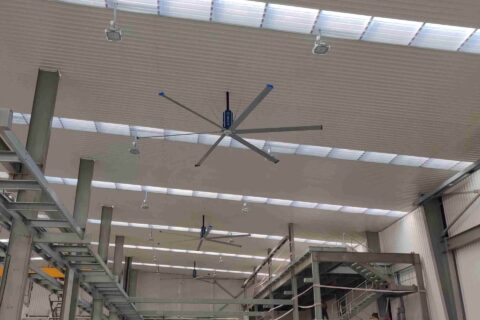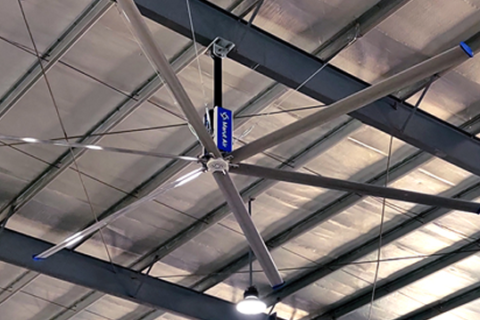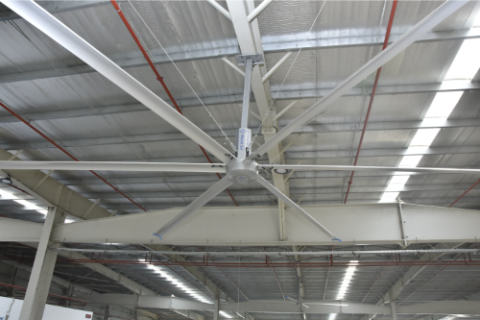High temperatures cause a number of issues for industry workers. As we approach the hottest months of the year, plant managers must have a strategy in place to reduce heat on their production floors. Understanding how to cool a manufacturing plant is essential for maintaining worker safety and productivity.
Why Are High Temperatures in Factories a Problem?
Factories produce a lot of heat as a result of heavy machinery, the manufacturing processes and the presence of large numbers of workers in confined spaces. If cooling mechanisms are not implemented, the high temperature can cause problems such as:
- Worker health hazards: Heat stress, fatigue, dehydration, abuse and lack of concentration.
- Loss of productivity: Inefficient output is caused directly by uncomfortable conditions.
- Physical issues with machinery: Machines can undergo failed equipment operations due to excessive heat and costly maintenance.
- High energy bills: Additional expenses from using inefficient cooling methods that generate an additional consumption of electrical units.
The Importance of Heat Reduction in a Factory
High temperatures in workplaces can increase health concerns as well as cause equipment problems, both of which can impair production and potentially endanger factory workers.
Heat Effects Health
Working on a manufacturing floor exposes you to a number of hazards due to the heat. Excessive heat or spending time in poorly ventilated spaces might impair the body’s capacity to maintain a healthy temperature. This causes heat cramps, heat exhaustion, and heat stroke, all of which can be fatal. For these reasons, adequate manufacturing cooling systems must be implemented.
To stay safe while working in extreme temperatures, personnel must take frequent breaks, stay hydrated, and eat healthy. If you work in multiple locations with varying temperatures, you may need to dress in layers to ensure that you are always wearing comfortable attire.
Heat Effects Equipment
Heat can harm the health of your staff as well as your equipment. Electronic equipment can run for 32 years at 45°C and four years at 80°C, according to the Arrhenius Equation. The need to repair equipment more frequently increases operational costs and harms a company’s bottom line. At 45 degrees Celsius, electronic devices can run for 32 years.
Heat can reduce output by causing equipment to run inefficiently or to fail completely. When equipment fails due to heat, the problem might be difficult to detect because the damage is generally inside, and damaged components may appear to function normally at first inspection. The damage is frequently not discovered until rigorous testing is conducted. This results in even more downtime and productivity loss.
Heat Delays Meeting Production Objectives
When factories are under pressure to fulfill output targets, they must ramp up their activities. This can result in both equipment and workers working longer hours than usual.
Temperatures may rise as a result of all of this extra activity. When machines work harder, they generate more heat, which contributes to rising manufacturing floor temperatures. If machines are not allowed to cool down, they may emit significantly more heat, work inefficiently, or even fail.
How to Reduce Temperature in Factory?
There are several effective ways to keep your factory cool with HVLS fans some of which include the following:
1. Improve Ventilation Systems
The right ventilation helps move the hot air out and bring the fresh, cool air in. The installation of industrial exhaust fans and roof ventilators will serve to remove hot air and reduce heat buildup while creating a balanced environment.
2. Use High Volume Low Speed (HVLS) Fans
HVLS fans are designed specifically to reduce indoor heat in large factories. As compared to traditional ceiling fans, an HVLS fan has large blades that move a large quantity of air at a constant speed and provide proper airflow throughout the entire space.
Benefits of HVLS Fans
- Reduced temperature with improved air circulation
- Savings on energy costs
- Even airflow without hot spots
3. Install Industrial Coolers
Industrial coolers can effectively lower indoor heat in factories or warehouses. They use water centric cooling technology to lower temperatures and consume less energy as compared to traditional air conditioning methods.
Benefits of Industrial Coolers
- Eco-friendly
- Cost-effective
- Ideal for large open spaces
- Lower operational costs
5. Insulation & Heat-Reflective Roofs
Providing insulation or heat-reflective coatings on factory roofs can keep external heat out. Reducing the ability of heat to permeate a building will allow for simpler, reduced internal climate and temperature management.
6. Optimize Layout & Operational Practices
Changing some small things can make a big difference:
- Place equipment that generates heat away from areas frequented by workers
- Guided airflow for workers and equipment should be the same
- Provide heavy production activities during slower & cooler times of the day
How Can You Avoid Factory Heat?
Moving air around on the factory floor can be enough to keep the facility cool in some cases. Fans that sit on the floor, are fixed on the walls, or are located elsewhere inside the facility transfer air from one location to another, creating a cooling effect. While conventional fans will not truly cool the air, the wind they produce will provide some respite to workers. If the primary purpose is employee comfort, fans may suffice.
Larger than ordinary fans, high-volume, low-speed (HVLS) fans can break up blocks of hot air and provide an even greater cooling impact. Some industrial HVLS fans are also integrated with smart technology that allows them to arrange when to run and collaborate with other cooling equipment. Managing factory temperature efficiently is crucial for maintaining a comfortable work environment. Consider employing fans to lower factory floor temperatures if temperatures are not excessively high or if your primary purpose is to provide relief to workers.
Conclusion
While manual methods may be sufficient to manage heat in some cases, more complex cooling equipment, such as HVLS fans, may be required in others, such as when manufacturers cannot open windows and doors to allow outside air into the facility. Dust, insects, and other contaminants can enter the outside air and wreak havoc on equipment and operations.
Marut Air understands how critical it is to keep all of your machinery in top working order. If you liked this resource and want to learn more about our HVLS fans and other ventilation product lines, please contact us right away.
Frequently Asked Questions About How to Reduce High Temperatures in Factory
Question 1. Why is it important to reduce the temperature in factories?
Answer. It is important for maintaining a comfortable temperature to ensure worker safety, prevent heat stress, improve productivity and protect from overheating.
Question 2. What are the most efficient cooling solutions for large factories?
Answer. For large factories, the most effective cooling solutions include HVLS fans, industrial air coolers, roof ventilation and exhaust systems.
Question 3. Are HVLS fans better than traditional fans for factory cooling?
Answer. Yes, because HVLS fans are designed specifically for large spaces and they move more air with less energy which makes them more effective and efficient as compared to traditional ceiling fans.
Question 4. How much energy can factories save by using efficient cooling solutions?
Answer. By using HVLS fans and industrial coolers, factories and industrial spaces can save up to 30% to 50% on energy bills.





